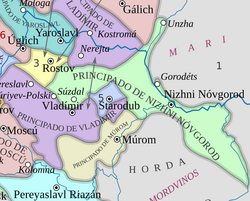Principality of Nizhny Novgorod-Suzdal
Principality of Nizhny Novgorod-Suzdal Нижегородско-Суздальское княжество Nizhegorodsko-Suzdalskoye knyazhestvo | |||||||||||
|---|---|---|---|---|---|---|---|---|---|---|---|
| 1341–1418[1] | |||||||||||
 Principality of Nizhny Novgorod c. 1350 | |||||||||||
| Capital | Nizhny Novgorod | ||||||||||
| Common languages | Old East Slavic, Russian | ||||||||||
| Religion | Russian Orthodoxy | ||||||||||
| Prince[2] | |||||||||||
• 1341–1355 | Konstantin of Suzdal (first) | ||||||||||
| History | |||||||||||
• Established | 1341 | ||||||||||
• Local dynasty replaced by Muscovite governor[1] | 1418[1] | ||||||||||
| Currency | ruble, denga, tenge | ||||||||||
| |||||||||||
The Principality of Nizhny Novgorod-Suzdal[2] (Russian: Нижегородско-Суздальское княжество), also known as Suzdal-Nizhny Novgorod (also spelt Nizhnii),[4] was a principality formed in 1341. Its main towns were Nizhny Novgorod, Suzdal, Gorokhovets, Gorodets, and Kurmysh.[5] Nizhny Novgorod was the seat of the principality from 1350. The prince Dmitry of Suzdal obtained the yarlik (patent) for the title of Grand Prince of Vladimir from khan Nawruz Beg in 1360.[2]
History
[edit]Konstantin of Suzdal merged the principalities of Suzdal and Nizhny Novgorod in 1341 with the approval of Jani Beg, who became Khan of the Golden Horde next year.[6] In 1341, after the death of Ivan Kalita, Khan Uzbek divided the main territories of northeastern Rus'. Part of the land, which included Nizhny Novgorod, Gorodets and Unzha, became the property of Prince Konstantin of Suzdal.[6] An independent Nizhny Novgorod-Suzdal Principality was formed, which occupied a vast territory. In the east, its border ran along the Sura River, in the southeast and south - along the rivers Pyana and Seryozha. The main stronghold in the east was the Kurmysh Fortress, founded in 1372. Along the border stood small fortresses, in which border guards lived. The remains of such fortresses are found along the Piana River in Buturlinsky and Sergachsky districts.[citation needed]
The bubonic plague hit Nizhny Novgorod again in 1365.[7]
In 1377, the Horde attacked Nizhny Novgorod. In the battle on Pyana River, the Russian army suffered a severe defeat from the Horde prince Arapsha.[8] Dmitry of Suzdal, who remained without troops, fled to Suzdal. The Nizhny Novgorod army fled to the neighboring Gorodets. On 5 August 1377, the Horde army conquered Nizhny Novgorod. The city was burnt. A year later, on July 24, 1378, the city was re-conquered.[9]
Nizhny Novgorod-Suzdal did not participate in the 1380 Battle of Kulikovo.[10] After the battle, the Horde Khan Tokhtamysh, in 1382 with a large army went to Moscow. When the Tatar army approached Nizhny Novgorod, Prince Dmitry Konstantinovich of Suzdal, wishing to save his land from ruin, sent his sons Vasily and Semyon to him, who went with the army and persuaded Moscow to surrender.[citation needed]
The death of Prince Dmitry Konstantinovich in 1383 triggered a decade-long war of succession between his brother and his sons.[1] In the end, khan Tokhtamysh awarded Nizhny Novgorod-Suzdal to Vasily I of Moscow in 1392.[1] The local Konstantinovich dynasty, supported by various Tatar warlords such as Edigei, refused to recognise the Daniilovichi claim for twenty more years, in 1410 even attacking and looting the city of Vladimir.[1] After Vasily I married off his daughter to a Suzdalian prince in 1418, and placed his own governors in Nizhny Novgorod, the Konstantinovichi ceased their resistance against Muscovite overlordship.[1]
List of princes
[edit]- Konstantin Vasilyevich (Prince of Suzdal) (Prince of Suzdal 1332–1341, Prince of Nizhny Novgorod–Suzdal 1341[6]–1355).
- Andrei Konstantinovich (Prince of Nizhny Novgorod–Suzdal 1355–1365).
- Dmitry of Suzdal (Suzdal since 1359, Nizhny Novgorod since 1365 – 1383)
- Boris Konstantinovich (1383–1394), brother of previous
- With the permission of khan Tokhtamysh of the Golden Horde, Vasily I of Moscow took over Nizhny Novgorod-Suzdal in 1393.[11]
| Yurievichi connection of Moscow, Novgorod-Suzdal, and Tver | |||||||||||||||||||||||||||||||||||||||||||||||||||||||||||||||||||||||||||||||||||||||||||||||||||||||||||||||||||||||||||||||||||||||||||||
|---|---|---|---|---|---|---|---|---|---|---|---|---|---|---|---|---|---|---|---|---|---|---|---|---|---|---|---|---|---|---|---|---|---|---|---|---|---|---|---|---|---|---|---|---|---|---|---|---|---|---|---|---|---|---|---|---|---|---|---|---|---|---|---|---|---|---|---|---|---|---|---|---|---|---|---|---|---|---|---|---|---|---|---|---|---|---|---|---|---|---|---|---|---|---|---|---|---|---|---|---|---|---|---|---|---|---|---|---|---|---|---|---|---|---|---|---|---|---|---|---|---|---|---|---|---|---|---|---|---|---|---|---|---|---|---|---|---|---|---|---|---|
| |||||||||||||||||||||||||||||||||||||||||||||||||||||||||||||||||||||||||||||||||||||||||||||||||||||||||||||||||||||||||||||||||||||||||||||
References
[edit]- ^ a b c d e f Martin 2007, p. 253.
- ^ a b c Martin 2007, p. 229.
- ^ Rein Taagepera (September 1997). "Expansion and Contraction Patterns of Large Polities: Context for Russia". International Studies Quarterly. 41 (3): 475–504. doi:10.1111/0020-8833.00053. JSTOR 2600793.
- ^ Martin 2007, p. 230.
- ^ Great Soviet Encyclopedia (1976), vol. 25, p. 57
- ^ a b c Martin 2007, p. 199.
- ^ Martin 2007, p. 222.
- ^ Mogilner, Marina B.; Gerasimov, Ilya V.; Glebov, Sergey; Semyonov, Alexander (19 October 2023). A New Imperial History of Northern Eurasia, 600-1700: From Russian to Global History. Bloomsbury Publishing. p. 170. ISBN 978-1-350-19681-0.
- ^ "Spiritual letters of the Moscow princes. Electronic library of the Faculty of History of Moscow State University". www.hist.msu.ru (in Russian). Retrieved 2017-07-26.
- ^ Martin 2007, p. 236.
- ^ Halperin 1987, p. 75.
Bibliography
[edit]- Halperin, Charles J. (1987). Russia and the Golden Horde: The Mongol Impact on Medieval Russian History. p. 222. ISBN 9781850430575. (e-book).
- Martin, Janet (2007). Medieval Russia: 980–1584. Second Edition. E-book. Cambridge: Cambridge University Press. ISBN 978-0-511-36800-4.
Text is available under the CC BY-SA 4.0 license; additional terms may apply.
Images, videos and audio are available under their respective licenses.

